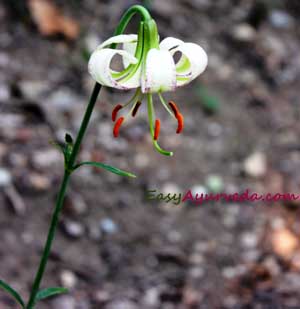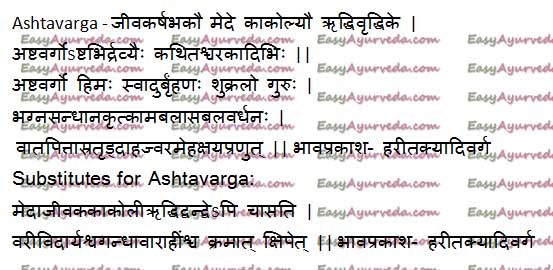Ashtavarga Group Of Herbs Benefits, Research

Ashtavarga is a group of 8 herbs (‘Ashta’ meaning eight and ‘Varga’ meaning Group) which are considered to have health benefits. The maximum health benefits are obtained by mixing the herbs and using it together.
Table of Contents
Ashtavarga
The 8 herbs of Astavarga are –
Kakoli-Roscoea purpurea
Kshirakakoli- Lilium polyphyllum – White Himalaya Lily
Jeevaka- Crepidium acuminatum
Rishabaka- Malaxis muscifera
Meda- Polygonatum verticillatum
Maha meda- Polygonatum cirrhifolium
Riddhi- Habenaria intermedia
Vriddhi- Habenaria edgeworthii

Qualities, Indications
Though each of the eight herbs has slightly different property, some common properties are found which helps in the therapeutic action in a group. All the herbs has the following common properties-
Rasa (Taste) – Madhura (Sweet)
Guna (Qualities) – Guru (Heavy), Snigdha (Slimy)
Vipaka – Madhura (Undergoes sweet taste after digestion)
Veerya (Potency) – Sheeta (Cold)
Karma (Actions) – Tridosha shamaka (reduces all the vitiated dosha)
Indications: The herbs can be used in the treatment of fracture of bones, fever, diabetes and provide strength to the person.
Part used, dosage, adjuvants
Part used- Root/Rhizome/Whole plant
Dose: About 2-3 g in divided dose/day
Anupana: Milk and Ghee are the preferred anupana during the intake of Astavarga dravya.
Acharya Bhavaprakasha has mentioned about some of the herbs individually-
Jeevaka and Rishabaka
Both Jeevaka and Rishabaka are found in the mountains covered with snow (Himalayan ranges). The tubers resemble to that of garlic i.e white colored, the leaves are tiny and do not possess any taste. Jeevaka plant has brush like leaves whereas the leaves of Rishabaka resemble to that of horn of an animal.
Both the herbs possess Madhura rasa (sweet taste) and have the property to bring down the Pitta dosha in the body. They increase the Kapha dosha, provide strength and vitality to the person.
Medha and Mahamedha
Both Medha and Mahamedha are climbers and resemble the rhizome of ginger in their appearance. Both the herbs possess Guru guna (Heaviness), increase the Kapha dosha and is beneficial in improving the vitality and strength of the person. They also improve the quality of the breast milk in lactating women. The herbs are beneficial to treat diseases related to vitiated Pitta and Rakta.

Kakoli and Ksheerakakoli
(White Himalaya Lily)
Both Kakoli and Ksheerakakoli are herbs which possess pleasant aroma in their rhizomes, slightly black to dull white in color. They are sweet in taste (Madhura rasa), have Sheeta veerya (Cold potency) and guru guna (Heaviness). They provide strength and are beneficial to treat diseases related to vitiation of Vata & pitta dosha, fever and debility of the body.
Riddhi and Vriddhi
Both the herbs Riddhi and Vriddhi are climbers with the rhizomes being the useful part. The rhizomes have small hairy like covering, white in color.
Riddhi provides strength and vitality to the body, pacify all the three vitiated doshas, has Guru guna, Madhura rasa (sweet taste). It is beneficial to treat unconsciousness, diseases related to vitiation of rakta and pitta dosha.
Vriddhi pacify the pitta dosha in the body. It is beneficial in providing strength to the uterus during pregnancy, treat condition of cough and debility and provide physical strength to the person.
At present all the eight herbs may not be available easily. Hence Acharya Bhavaprakasha has mentioned substitute herbs for some of the herbs.
Shatavari, Vidarikandh, Ashwagandha and Varahikandh can be substituted in place of Medha, Jeevaka, Kakoli and Riddhi respectively.
That means,
For Meda and Mahameda, the substitute is Shatavari
For Jeevaka and Rishabhaka, the substitute is Vidarikanda
For Kakoli and Ksheerakaoli, the substitute is Ashwagandha
and
for Riddhi and Vruddhi, the substitute is Varahikanda (Dioscorea bulbifera)
Research articles
Research articles related to herbs of Ashtavarga:
Anti- oxidant action: The study aims for nutritional characterization, chemical profiling of R. purpurea (tubers) methanol extract (RPE) along with evaluation of its anti-oxidant activity. Physicochemical and nutritional content were estimated as per standard protocols. Chemical profiling of markers includes method optimization, identification & quantification of bioactive poly phenolics through HPTLC. Anti- oxidant potential RPE was analyzed via. Total phenolics (TPC), total flavonoids (TFC), reducing power assay, DPPH and β-carotene bleaching model. Tubers of R. purpurea exhibit immuno- modulatory [4] and anti-diabetic activity.
TPC, TFC and Anti- oxidant activity: We focused on estimation of total phenolic content, total flavonoids content and in vitro antioxidant potentials by three methods i.e. reducing power method, Total antioxidant activity by Ammonium molybdate method and Ferric Reducing Antioxidant Powder method. The phenolic content with respect to gallic acid was found to be 70.9 ± 0.53 (µg gallic acid equivalent/ml of extract) for methanol extract. The flavonoid content was found to be as: 34.27 ±0.61 (µg quercetin equivalents/ml of extract) in methanol extract Three types of extracts were used for anti-oxidant studies: aqueous, hydroalcohlic and alcoholic. It was concluded that aqueous extract has more potential as antioxidant as compared to hydroalcolic and alcoholic extracts.
Anti- oxidant action: The antioxidant activity of Malaxis acuminata (Ref. NISCAIR/RHMD/Consult/-2011-12/1717/17) was studied with the various available methods including 1, 1-diphenyl-2-picryl hydrazyl (DPPH) radical scavenging activity, Reduction capability by Fe3+-Fe2+ Transformation method and Hydrogen peroxide scavenging method. Various data obtained is laid down in the tables given below and it was found that the extract showed a good antioxidant activity.
Anti- inflammatory activity: The present study describes the trachea relaxant and anti-inflammatory effects of Polygonatum verticillatum which may support its medicinal use in hyperactive airway complaints and inflammatory disorders. Results indicate that the plant possesses trachea relaxant, mediated possibly through a Ca2+ channel blockade mechanism, and anti-inflammatory activities, which may explain the medicinal use of this plant in airway disorders and inflammation.
Hepato- protective potential: The purpose of the study was to assess the effects ethyl acetate and ethynolic extracts of tubers of Habenaria intermedia against Carbon tetrachloride (CCl4, 0.7 ml/kg.p.o. in liquid paraffin 1:1, i.p.) induced hepato toxicity in rats. The hepato- protective effect of extracts was evaluated by the assay of liver function and biochemical parameters such as SGOT, SGPT, SALP, serum bilirubin and cholesterol. Histopathlogical studies of liver sections of animals treated with extract showed regeneration of hepatocyts, absence of necrosis and fatty infiltration, which further give evidence for the hepato-protective activity.
Aphrodisiac property: In the present study, we examined the effect of Polygonatum verticillatum leaf aqueous extract upon the expression of male rat sexual behavior, in order to know whether Polygonatum verticillatum leaf aqueous extract possess aphrodisiac property. Present findings provide experimental evidence that the Polygonatum verticillatum leaf aqueous extract possesses aphrodisiac property.
Ayurvedic medicines
Some ayurvedic medicines containing Ashtavarga:
Ashta varga kashaya: It is used in the treatment of Vata diseases like joint diseases, bloating, arthritis, fever and joint pain, rheumatoid arthritis etc.
Chyavanaprasha: It is effective in the management of respiratory diseases, acts as rejuvenator, improves the immunity system of the body, pain in the joints, improves the complexion of skin, beneficial for hair growth, improves the appetite etc.
Author: Dr.B.K.Prashanth M.D (Ayu), Ph.D
E mail: [email protected]
Click to consult Dr Prashanth BK










